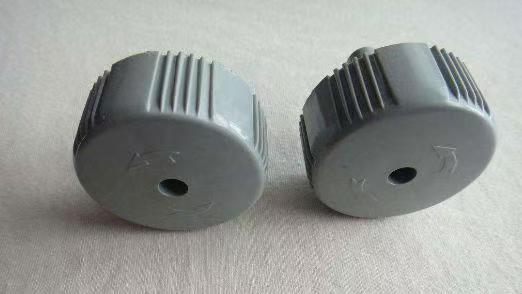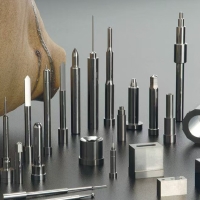สาเหตุและการแก้ปัญหาของรอยบุบเกี่ยวกับผลิตภัณฑ์ที่ฉีดขึ้นรูปผลิตภัณฑ์สำเร็จรูปที่ไม่สมบูรณ์และแฟลชเกี่ยวกับผลิตภัณฑ์
สาเหตุและการแก้ปัญหาของรอยบุบเกี่ยวกับผลิตภัณฑ์ที่ฉีดขึ้นรูปผลิตภัณฑ์สำเร็จรูปที่ไม่สมบูรณ์และแฟลชเกี่ยวกับผลิตภัณฑ์
สินค้า Mould_Taizhou jiefeng Mold Co.,Ltd. (jfmoulds.com)
| ข้อบกพร่องของผลิตภัณฑ์ | เหตุผลที่เป็นไปได้ | สารละลาย |
| การเยื้องผลิตภัณฑ์ | (1) สารประกอบยางไม่เพียงพอในโพรงเชื้อราทำให้เกิดการหดตัว 1. การเติมไม่เพียงพอหรือจำนวนการให้อาหารไม่เพียงพอ 2. ตัวแก้ไขตำแหน่งประตูหรือความไม่สมดุลของประตู 3. นักวิ่งหรือประตูไม่เพียงพอหรือเล็กเกินไป 4. ความหนาของผนังของผลิตภัณฑ์ไม่สม่ำเสมอและรอยบุบมีแนวโน้มที่จะเกิดขึ้นที่ด้านหลังที่พื้นที่กำแพงหนา | ดำเนินการปรับและแก้ไข 1. เพิ่มการให้อาหารหรือเปิดประตูพอร์ตที่กว้างขึ้น 2. ควบคุมกาวหลอมเหลวทั้งหมดจากการไหลเข้าไปในประตู Sprue และป้องกันไม่ให้ไหลเข้าสู่ประตูอื่น 3. เพิ่มจำนวนช่องนักวิ่งและขยายขนาดประตู 4. การทำงานของการทำงานสามารถแก้ไขได้หรือความดันฉีดสามารถเพิ่มขึ้นได้ |
(2) การปรับพารามิเตอร์เทคโนโลยีกระบวนการที่ไม่เหมาะสม 1. ความดันฉีดต่ำและความเร็วในการฉีดช้า 2. การตั้งค่าเวลาการฉีดสั้นเกินไป 3. การตั้งค่าเวลาการถือแรงดันสั้นเกินไป 4. การตั้งค่าเวลาเย็นสั้นเกินไป | ดำเนินการปรับและแก้ไข 1. ปรับและเพิ่มแรงดันฉีดและความเร็วในการฉีด 2. เพิ่มค่าการตั้งค่าของเวลาการฉีด 3. เพิ่มค่าการตั้งค่าเวลาการถือแรงดัน 4. เพิ่มค่าการตั้งค่าเวลาการระบายความร้อน | |
(3) พลาสติกร้อนเกินไป 1.The plastic is overheating and the temperature setting of the melt cylinder is too high 2.The mold temperature is too high. 3.There is local overheating in the mold or overheating when the product is demolded | ดำเนินการปรับและแก้ไข 1.Reduce the temperature setting value of the melt glue cylinder 2.Reduce the mold temperature and adjust t3.he inlet gate valve of the cooling system | |
| (4) The material temperature is too low or the plasticization is poor, resulting in poor flow of the molten material | Increase the temperature of the heating zones in each section of the melt glue cylinder to test the degree of plasticization of the rubber compound | |
| The finished product is not satisfactory | 1.The material "Bridges" in the hopper, resulting in insufficient feeding. 2.Insufficient injection volume, inadequate plasticizing capacity and insufficient leftover material. 3.The diversion channel is insufficient or the gate is small. 4.The flow state of the molten adhesive flowing into the multi-cavity die cannot be properly balanced. 5.The amount of molten glue in the mold cavity is greater than the injection volume of the injection molding machine. 6.The flow resistance of the mold gating system is large, the position of the feed port is improper, the cross-section is small and the form is poor, the flow process is long and tortuous. 7.Air cannot be expelled from the mold cavity. 8.The plastic contains a lot of moisture, volatile substances or has a large amount of gas in 9.the molten material. 9.The nozzle temperature is low, the barrel temperature is low, causing blockage, or the nozzle hole diameter is too small. 10.The injection pressure is low and the injection speed is slow. 11.The injection time setting is too short. 12.The pressure-holding time setting is too short. 13.The fluidity of the plastic is too poor, resulting in excessive flash and overflow. 14.The mold temperature is too low and the plastic cools down too quickly. 15.Excessive use of demolding agent, moisture in the mold cavity, etc. 16.The wall of the product is too thin, the shape is complex and the area is large. | 1. Inspect the water transport ring cooling system to eliminate the "bridging" phenomenon 2.Reduce the injection volume to maintain a fixed material intake and enhance the plasticizing capacity 3. Add more runner channels or increase the gate size 4. Correct the situation of unbalanced flow state 5. Use a larger injection molding machine or reduce the number of model cavities in the working mold 6. Improve or modify the mold gating system, including aspects such as the position, cross-section, form and flow of the feed inlet 7. Increase the number or size of exhaust ducts 8.Before plastic injection molding, it should be dried to ensure the mixing ratio and reduce impurities 9. Increase the temperature of the barrel and the nozzle to ensure adequate plasticization, and replace the nozzle with a larger aperture 10. Increase the values of injection pressure and speed parameters 11. Increase the setting value of the injection time parameter 12. Increase the setting value of the pressure-holding time parameter 13. Correct the parameter values of the temperature setting to prevent material overflow 14. Adjust the mold temperature and cooling time 15. Reasonably control the dosage of mold release agent to prevent excessive moisture 16. Try your best to reduce the complexity of the products |
| Product flash | 1.The projected area of the product exceeds the maximum product area allowed by the injection machine 2.The mold is installed incorrectly or subjected to unidirectional force 3.The injection molding machine template is not parallel or the tie rods are unevenly deformed 4.Poor parallelism of the mold or obstruction at the mold edge 5.The parting surface of the mold does not fit well, and the clearance between the cavity and the core or the sliding parts is too large. 6.The plastic has too much fluidity and the feeding amount is too large 7.The cavity material temperature is high, and the mold temperature is too high 8.The injection pressure is too high and the injection speed is too fast 9.The clamping force is not constant or uneven | 1.Choose a larger injection molding machine or select products of an appropriate area Mold 2. Check the installation of the mold and secure and press it tightly 3. Check whether the template and the tie rods are parallel and make corrections to eliminate deformation 4. Clean or grind the mold edges and check the parallelism of the mold 5. Check whether the parting surface of the mold is clean and free of debris, correct the offset or clearance, or replace the parts 6.The feeding amount is properly controlled 7. Control the temperature of the heating melt glue cylinder and the mold temperature 8. Reduce the setting of injection pressure and speed parameter values 9. Adjust the clamping force parameters or correct the symmetry on both sides of the die |

ข้อมูลที่เกี่ยวข้อง
ส่วนมาตรฐานของแม่พิมพ์
2025-07-24
ชิ้นส่วนมาตรฐานของ Molds1 Mold FramePrefabricated Assemblies ฐานแม่พิมพ์มาตรฐาน o ...
แม่พิมพ์ฉีด: การวิเคราะห์ที่ครอบคลุมจากงานฝีมือที่มีความแม่นยำไปจนถึงการใช้งานที่หลากหลาย
2025-06-30
แม่พิมพ์ฉีด: การวิเคราะห์ที่ครอบคลุมจากงานฝีมือที่แม่นยำไปจนถึงนักดำน้ำ...
แม่พิมพ์ฉีด: รากฐานที่สำคัญของการผลิตที่แม่นยำและแนวโน้มใหม่ในการพัฒนาอุตสาหกรรม
2025-07-08
แม่พิมพ์ฉีด: รากฐานที่สำคัญของการผลิตที่แม่นยำและแนวโน้มใหม่ใน...
การออกแบบแม่พิมพ์หลายแบบ
2025-07-25
การออกแบบแม่พิมพ์หลายแบบในการติดฉลากแบบ processhin-walled บรรจุภัณฑ์พลาสติก produ ...
กระบวนการออกแบบกระบวนการผลิตแม่พิมพ์
2025-06-19
การไหลของกระบวนการ1.การผลิตแม่พิมพ์มีดังนี้: การตรวจสอบการวาดภาพ-วัสดุ...
ลักษณะการทำงานและเกณฑ์การเลือกของแม่พิมพ์ฉีด
2025-06-30
ลักษณะการทำงานและเกณฑ์การเลือกของแม่พิมพ์ฉีดนี้...





